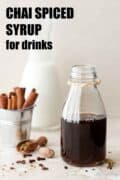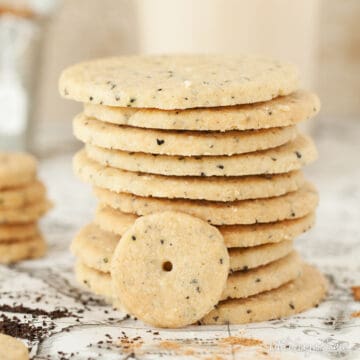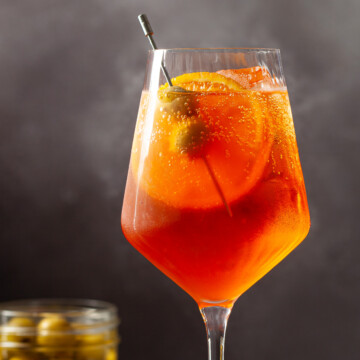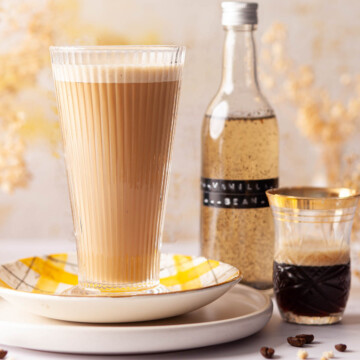Chai latte syrup is a sweet, dark & intense syrup that is useful for flavouring drinks and recipes with a delicious blend of Indian spices. This homemade chai syrup recipe is easy & cheap to make at home so it will help to reduce your coffee-shop bill.

Want to Save This Recipe?
Why this recipe is worth making
- Masala syrup is easy to make.
- It does not contain tea so it can be used in plenty of other drinks and recipes, not just tea.
- It has a concentrated flavour – only a little is needed to impart those sensational notes of spice to the drink and it keeps the drink from getting overly sweet.
- You can make a large batch and keep it handy in the fridge for 3-4 weeks for when time is in short supply.
Chai latte syrup is always welcome with me throughout the cooler months of the year. I have a soft spot for drinks infused with spices, especially the likes of cinnamon, ginger and nutmeg, which are all present in this homemade chai syrup recipe.
Coupled with a hint of vanilla and a dark, sweet base made from demerara sugar, this mix of spices creates a wonderful profile of flavours. It is dark, sultry, sweet, highly flavoured and makes a tasty addition to so many drinks, such as a milky latte.
Chai latte syrup can go by numerous other names including chai syrup, masala syrup, masala chai syrup, chai simple syrup and chai spice syrup. And if you like the sound of it you’ll most likely enjoy my homemade gingerbread syrup too.
What is chai latte syrup?
To appreciate what chai latte syrup is and how it should be used, it’s important to understand what masala chai – the inspiration for this recipe – is.
What is masala chai?
Traditional masala chai originates from India. It is strong-brewed tea infused with Indian spices – usually including cardamom, cinnamon, cloves, ginger and black pepper. It’s often made with around 50% water and 50% milk and it is generously sweetened before serving.
Over the last few years, this tea seems to have etched out a cosy and permanent place on the blackboard menus in chain cafes across the UK, many of which rely on syrups to add the spice profile of the drink they are trying to replicate.
Masala chai translates as spiced tea since masala means spice and chai means tea. So technically, when we wander into coffee shops and see chai tea, chai tea latte or chai latte listed on the menu, this is a misuse of the word chai.
In fact, what we are actually asking for in these instances is tea tea (haha), tea tea latte or tea latte. What we should be asking for is masala chai, masala chai latte or masala latte.
So what is masala chai syrup?
It’s basically a chai simple syrup. That’s a syrup made from sugar and water with the typical spices present in masala chai infused into it.
Although fresh, authentically brewed Indian-style spiced tea is always preferable, making this chai syrup recipe offers a shortcut to knocking up spiced tea drinks at home when time is short.
Technicality note
Because of the now widely accepted (incorrect) terminology described above I’ve decided to keep the word chai in my recipe title even though this chai simple syrup recipe does not contain tea.
If you would like to use this syrup to make Indian-style spiced tea, then you will need to brew your tea and add this syrup to flavour and sweeten it. And I’d like to offer my deep apologies to the purists reading this.
Ingredients notes

Sugar: I’ve opted for demerara sugar over white sugar to add depth, complexity and a certain mellowness to the final chai spice syrup produced by this recipe. Demerara adds divine undertones of toffee to the syrup, which seems to work well with the spices.
Spices: there are four spices that are common in most Indian spiced tea recipes:
- cinnamon
- ginger
- cloves
- green cardamom
But this list is not exclusive. It’s there to be added to. I’ve got my own favourite blend that includes the following spices along with the base four:
- nutmeg
- allspice
- vanilla
- black peppercorns
- star anise
Fennel seed is another favourite addition for many, though I’ve yet to try this.
Step by step instructions
- Begin by putting the sugar and water into a small saucepan and place it over medium heat to dissolve the sugar.
- Put the cloves, nutmeg, black pepper and allspice berries into the mortar and give them a gentle bash with the pestle (don’t grind them). Add the cinnamon and hit just to break it up. Split the cardamom pods.
- Once the sugar has dissolved, tip the dry spices, including the star anise, along with the slivers of fresh ginger into the pan and bring to the boil, then remove the pan from the heat.
- Let the syrup steep for 2 hours.
- Strain it through a fine-meshed sieve or nutbag to remove the chunks of spices.
- Stir through the vanilla extract then pour it into a bottle.
- Store it in the fridge for up to 4 weeks.

Expert Tips
- Don’t be tempted to shorten the infusing time. It is vital to let the spices impart their flavour by resting them in the syrup for the full 2 hours.
- Feel free to vary the spices according to your own taste preferences.
- If there’s a spice you dislike, leave it out.
- If you really adore a particular spice consider adding a little more in.
- Strain through a nutbag, filter cup or muslin cloth to remove all traces of spice from the syrup.
Frequently asked questions
It’s fine to substitute white sugar for the demerara. The colour of your chai syrup will be lighter and the flavour of the drink will vary slightly too. Demerara adds an extra level of complexity and mellowness that white sugar does not.
Yes, you can, although the spice profile of the syrup is likely to be slightly muted following freezing. It’s a good idea to freeze it in ice cube trays so a single portion can be used at a time.
As this syrup contains no tea, it does not contain caffeine. When added to brewed coffee or tea the resulting drink will, however, contain caffeine unless a decaffeinated version is used.
What can I make with chai latte syrup?
This chai latte syrup can be used to create a number of masala chai drinks including:
- Masala chai (aka chai tea) – spiced strong-brewed tea, made with part water and part milk. It should be liberally sweetened.
- Masala chai latte (aka chai tea latte) – A 100% milk version of the above drink.
- Iced chai latte – as above but prepared with cold milk and served over ice.
- Masala latte (aka chai latte) – spiced milk (no tea), served warm. It is usually sweet.
- Dirty chai latte – spiced milk with a shot of espresso coffee added to it.
- Chai cocktails – such as my chai latte martini or you could use it in place of pumpkin spice to make a chai spice espresso martini.
This chai spice syrup is intensely flavoured and designed to be diluted in drinks. Aside from the drinks listed above it can also be used to add a spice profile to
- Hot chocolate
- Warm apple juice
- Cream
- Yoghurt
- Porridge
The exact amount needed for each drink will vary according to the size and your taste preferences. Start by adding a small amount, then taste and add more syrup as necessary.
Note: I do not recommend pouring this syrup over waffles or pancakes – the flavour is too intense for this use.

More chai spice recipes to try
If you have tried this recipe for chai latte syrup please give it a rating or leave a comment – I love to hear how you get along with my creations.
Why not sign up to receive LittleSugarSnaps newsletters to hear when new recipes are published? You’ll get a free welcome e-book with my top baking tips and 5 favourite cake recipes. Or stay in touch on socials:
📖 Recipe
Want to Save This Recipe?

Chai Latte Syrup
Ingredients
- 100 g Demerara sugar
- 100 ml Water
- 2 Cinnamon sticks each 10cm
- 5 Cardamom pods
- 5 Black peppercorns
- 6 Cloves
- ½ clove Nutmeg
- 3 Allspice berries
- 1 Star anise
- 3 slices Fresh ginger (1mm thickness) – approx 7g in total
- ½ teaspoon Vanilla extract
Instructions
- Begin by putting the sugar and water into a small saucepan and place on a medium heat to dissolve the sugar
- Meanwhile prepare the spices – snap the cinnamon stick in half and then hit it several times in a pestle and mortar to break it up a little more (don’t grind it). Tip the chunks of cinnamon into a small bowl
- Next split the cardamom pods (a swift whack with the pestle should do the trick). Add the split pods and seeds to the cinnamon
- Put the cloves, nutmeg, black pepper and allspice berries into the mortar and give them a gentle bash with the pestle. Again, do not grind to a powder
- Once the sugar has dissolved, tip the dry spices, including the star anise, along with the slithers of fresh ginger into the pan and bring to the boil, then remove the pan from the heat
- Let steep for 2 hours then strain to remove the chunks of spices (either a nutbag or muslin is best for this)
- Stir through the vanilla extract and pour into a bottle
- Store in the fridge for up to 4 weeks
Notes
- Don’t be tempted to shorted the infusing time. It is vital to let the spices imaprt their flavour into the syrup for the full 2 hours
- Feel free to vary the spcies according to your own taste preferences
- If there’s a spice you dislike, leave it out
- If you really adore a particular spice consider adding a little more in
- Strain through a nutbag, filter cup or muslin cloth to remove all traces of spice from the syrup
- It’s fine to substitute white sugar in place of the demerara. The colour will be lighter and the flavour of the drink will vary slightly too. Demerara adds an extra level of complexity and mellowness that white sugar does not











Karly W
I have scoured recipes to make a tea concentrate using all of the great spices. I found some that looked worthwhile to experiment with but they always ended up on the back burner while I kept looking for just the right recipe. When I came across your syrup I knew it was what I was looking for. I adjust the spices to my liking and do a quick pan roast on the stove of the crushed spices to enhance the flavor prior to adding them to the simple syrup. I also use a little honey as well. I love the concentrate and double or triple the recipe so I can share it. It is cost effective as well. Thank you.
Jane Coupland
Ah Karly – thanks for your comment and that’s a great tip to roast the spices briefly to help deepen the flavour – I think I’ll add that into my recipe steps asap.
Brad Wendzel
Hello Jane,
I ran across this in my search to flavor my Kambucha during the second fermentation. I really would rather not put “things” into the bottle that have to be filtered back out (as I might be drinking out of the bottle). I’ve had some interesting successes with Tonic syrups in the past so it seemed like a logical way to flavor the Kambucha. My question is why have you added the sugar prior to seeping? It seems to me that is would slow the process. I don’t mean to deep dive into the science but with all of the tonic simples or syrups, the seeping of the fruits and botanicals was in water and then the sugar added. Is the a reason or just the way you started doing it and “if it isn’t broke, don’t fix it”?
Jane Saunders
Hi Brad, thanks for getting in touch. Just to clarify, you’re asking me why I dissolve the sugar and then allow the spices to steep in the hot syrup rather than letting the spices infuse in cold water first? It’s simply so I don’t have to heat the liquid twice. I always infuse spices in hot liquid as the process is much quicker than it would be in cold (I’d expect to leave them in cold water for days and days). It also means that I can do a quick taste test at various points to ensure my syrup is flavoured as strongly as I’d like it to be – if not I’ll leave it for longer and test again. That’s harder to do if the sugar has yet to be added. It’s best to let everything infuse in a pan or bowl and then strain the spices out before pouring into a bottle so you don’t end up with things stuck in there.
Hope I understood your query properly – if not just give me another yell.
I notice that you mention drinking from the bottle as a reason you don’t like to leave things in the bottle, so just want to double-check that you appreciate this is a flavoured syrup intended for diluting in liquids such as milk, hot chocolate and tea rather than consuming as a stand-alone drink.
Anne Veenstra
To help with your choice of what to call it, masala simply means ‘spice mix’. So you can have korma masala to make korma, vindaloo masala to make vindaloo, garam masala for various Indian dishes etc. So technically what we are doing here is making ‘chai masala’ or ‘tea spice mix’ to make tea.
I make my chai masala and add to loose tea (either black tea or rooibos) then just brew 1 tsp of blend per cup. However, I want to try syrup for the convenience. For those not wanting the sugar, perhaps substitute with honey?
Jane Saunders
Hi Anne, I haven’t tried it with honey, but it sounds tasty – I might just have to give it a go myself 😉
Stan E.
Question… Several of the masala (chai spice) recipes I’ve seen say to break the cardamom pods and then throw out the seeds, some say to grind the seeds but toss the pod, and a few use the whole pod (broken or ground), but your recipe isn’t clear on that point in step 3 of the instructions. Do you use the seeds or toss them? I’d presume they’re more bitter than the pod is, but haven’t found a decent Indian grocer yet to buy the green pods for testing, and I only have ground spice to play with.
I’m trying to reverse-engineer the Celestial Teahouse ‘Dirty Chai’ tea bags, since they’re impossible to find in the stores regularly. I much prefer Celestial to Tazo, Allegro and other chai teas I’ve tried as it has a stronger taste and nose, but it’s sooo hard to find that I’m stuck with attempting to make it myself.
Jane Saunders
Hi Stan, thanks for getting in touch. I use the whole of the split cardamom – pods and seeds in step three. I’ve updated the recipe to make this more clear – thanks for bringing it to my attention. Hope you enjoy my syrup. It’s my rendition of masala chai, but feel free to play about with the spices if you like more/ less of certain ones.
Jean | DelightfulRepast.com
Jane, I had to laugh over your indecision over the word “chai” — I might have written that myself! 😀 And American terms/English terms? I’ve always done a strange mix of those throughout my life. Though I’m in the US, my mother’s family came over from England, plus I grew up reading English literature and cookery books. When I was 9 or 10, the word “honor” came up on our spelling lesson one week at school. On the spelling test I spelled it “honour” and it was marked as incorrect. I took issue with that with the teacher, and she gave me the word but told me to go with American spellings from then on!
Jane Saunders
ah, poor you, but well done for correcting your teacher! I absolutely love the word ‘fall’ but feel a fraud using it as I’m not American. But fall just tells you exactly what is happening all around you as the leaves and fruits come tumbling down. Thanks for stopping by Jean.
Tracy | Baking Mischief
I laughed so hard at this. It sounds like the hours I spent AGONIZING over whether to use “panino” or “panini” in a post earlier this year. 😉
Whatever you call it, this looks so good! I can’t wait to see the recipes you make with it.
Jane Saunders
Haha. And don’t get me started on whether I should adopt American terms or stick with English. It’s a minefield out there.
Miranda
Wow! I would love to try making this! I love getting chai tea lattes but they always are painfully expensive!
Jane Saunders
Oh I know that feeling – when you pop in for a quick drink and end up with an empty purse. Hopefully this syrup will help.
Tamar
Are you really supposed to use only 100 mL of water? I mean…in my typically-sized (I think) saucepan that would be so shallow it would barely cover the spices.
Jane Saunders
That’s right – I make mine in a milk pan. By all means double the entire recipe if you don’t have a small pan. It’s intended to be a highly concentrated flavour though, for diluting in drinks rather than for pouring.
kate
This looks amazing Jane – do you think it could work as a new Cracking nuts flavour?
Jane Saunders
Thanks Kate. Do you know, I think it might be a great seasonal flavour – I may have whip up a batch of nuts to try it out now you’ve suggested it.
Lynn | The Road to Honey
Well. . .as always Jane. . .beautiful photos of a beautiful syrup. Masala chai tea is one of my favorite fall & winter treats. If it weren’t for the sugar, I probably would drink it exclusively (with soy or coconut milk) throughout the chilly months. Btw. . .we seemed to have had our first true nippy day yesterday. . .and boy was I NOT prepared for it. I froze my booty off while walking the dog. Lucky me. . .she decided she was going to take her good old sweet time conducting her business. I really needed a nice warm cup of chai tea at that moment. 😉
Jane Saunders
Ah, thankyou so much Lynn. We’ve not yet gone too chilly over here, but I have had a terrible cold all week (that’s why I’ve not got around to posting any actual drink recipes as planned) and that’s reason enough to drink Masala Chai Tea for me. It’s a shame all the best drinks are sugary – at least with homemade you can cut it down a little – especially when the syrup has been made nice and punchy with that in mind.